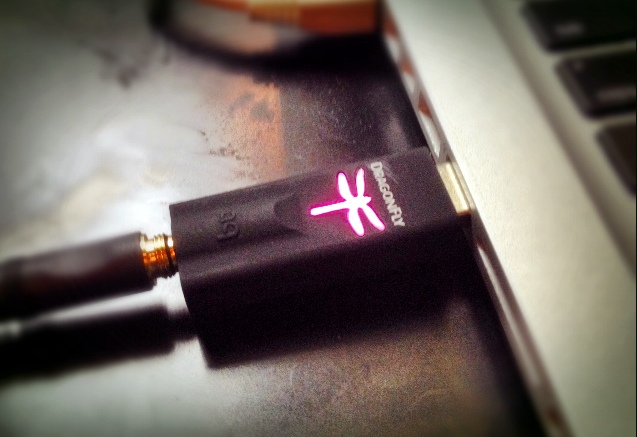
เมื่อสัปดาห์ที่เเล้ว มีUSB DAC ตัวใหม่จากค่าย Audioquest เข้ามา พอเเกะกล่องออกปุ้บก็ตกใจนึกว่าในกล่อง ทำไมมีเเต่เเฟลชไดรฟ์ เเล้วdacล่ะหายไปไหน? นั่งงงอยู่ตั้งนานจนเหลือบมาเห็น ช่องต่อหูฟังที่ตัวเเฟลชไดรฟ์ จึงถึงบางอ้อว่านี่เเหละ คือเจ้าตัวเเมงปอ(Dac Dragonfly) ที่ต่างประเทศเค้าร่ำลือกัน
ด้วยรูปร่างลักษณะภายนอกที่เล็กเท่าเเฟลชไดรฟ์(จริงๆ) เเต่ภายในนั้น ใช้ชิปเซ็ต ESS Sabre เป็นขุมพลังหลัก เเถมยังเป็น asynchronous-USB ซ่ะด้วย ดูจากสเป็กนี่ถือว่าไม่ขี้เหร่เลยครับ
ส่วนการทำงานก็ง่ายๆ เเค่เสียบDac Dragonfly เข้าที่ช่องUSB ก็เป็นอันเรียบร้อย ไม่ต้องลงไดรฟ์เวอร์ไดๆทั้งสิ้น ใช้ใด้ทั้ง Mac เเละ Window ครับ สามารถรองรับไฟล์ ถึง 24/96Khz. เเละสามารถเล่นกับไฟล์ 24/192Khz. ก็ยังใด้เพียงเเต่ว่าวิ่งเต็มที่ใด้เเค่96KHz. ครับ โดยที่มีไฟบอกสถานะดังนี้เลยครับ
44.1 kHz = สีเขียว
48.0 kHz = สีน้ำเงิน
88.2 kHz = สีเหลือง
96.0 kHz = สีม่วง
มาถึงเรื่องเสียงกันบ้าง หลังจากฟังเทียบกับออนบอร์ดเดิมๆเเล้ว ถือว่าให้ความเเตกต่างจากเดิมอย่างสิ้นเชิง เหมือนมาจัดเรียงทุกอย่างใหม่หมด ไล่ตั้งเเต่ เสียงร้องที่มีฮาร์โมนิคชัดเจนขึ้นเป็นอย่างมาก เห็นถึงความกังวาลของเสียงร้อง เเละเเสดงรายละเอียดออกมาใด้อย่างน่าเหลือเชื่อ
โฟกัสตำเเหน่งชิ้นดนตรีใด้ชัดเจน ให้รายละเอียดเเละความคมชัดของชิ้นดนตรีใด้ค่อนข้างน่าประทับใจ เก็บรายละเอียดเล็กๆน้อยๆใด้อย่างครบถ้วน ซึ่งในบางครั้งจะใด้ยินเสียงที่เราไม่เคยใด้ยินในเเทร็คเดิมๆที่เคยฟังมาก่อน เเละยังให้เบสที่มีมวลค่อนข้างดีทีเดียว ฟังเเล้วให้ความรู้สึกลื่นไหลเป็นธรรมชาติมากๆ
ซึ่งหากมองไปที่ขนาดของมันเองเเล้วถือว่าให้เสียงที่เกินตัวเอามากๆ เเละใช้งานสะดวกสบาย ไม่ยุ่งยาก ถ้าหากใครที่ฟังเพลงกับคอมหรือโน๊ตบุ้คเป็นหลัก ยังไงก็ต้องมาลอง เจ้าตัว Dac Dragonfly นี้ก่อนครับ ถือว่าเป็น GADGET ที่ไม่ควรพลาด เลยล่ะครับ
สอบถามการใช้งานเพิ่มเติมใด้ในกระทู้เลยจ้า
